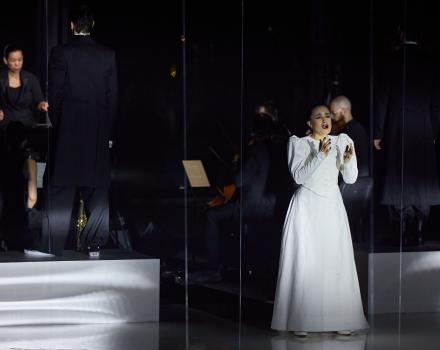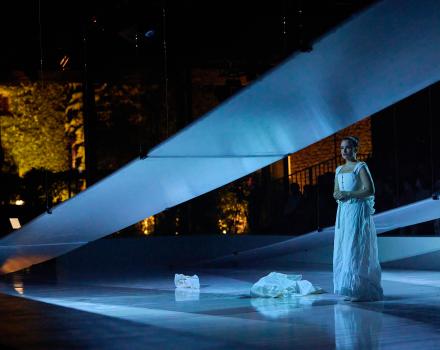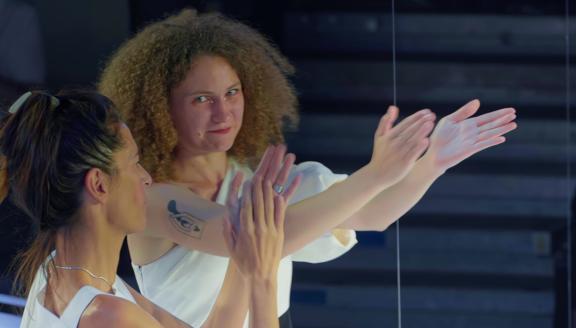
In the early 20th century, Countess Carmen Díaz de Mendoza Aguado, inspired yet frustrated by Mozart’s Don Giovanni, sets out to write her own version but struggles with doubt, societal pressures, and a haunting inner voice, leading to her play’s failure. Decades later, fragments of her life and work resurface through obituaries and fading memories. In 2024, a modern composer seeks to rediscover and reinvent her lost opera, conversing with the echoes of the past to reclaim the Countess’s silenced voice and vision.
This is the story of a new opera by Helena Cánovas, commissioned by the Festival Perelada, in co-production with the Gran Teatre del Liceu and the Teatro Real. Don Juan no existe seeks to pay homage to all those women who have been erased from history simply for having been born women. Staged at the internationally renowned Perelada Festival, which is held every summer in the monumental complex of the Perelada Castle in Catalonia.
CAST
|
Carmen Díaz de Mendoza
|
Natalia Labourdette
|
|---|---|
|
Helena
|
Natalia Labourdette
|
|
Augustin / Don Juan
|
David Oller
|
|
Miguel
|
Pablo García-López
|
|
Saxophone
|
Helena Otero
|
|
Percussion
|
Miquel Vich
|
|
String quartet
|
Cosmos Quartet
|
| ... | |
|
Music
|
Helena Cánovas
|
|---|---|
|
Text
|
Alberto Iglesias
|
|
Director
|
Bárbara Lluch
|
|
Conductor
|
Jhoanna Sierralta
|
|
Sets
|
Blanca Añón
|
|
Costumes
|
Clara Peluffo Valentini
|
|
Lights
|
Urs Schönebaum
|
|
Sound
|
Sixto Cámara
|
| ... | |
VIDEOS
Story
Act I
We are in the early 20th century. A Countess attends a performance of Mozart’s Don Giovanni accompanied by two close friends. She observes the stage, the characters, the music, but fails to connect with the piece; why watch (yet again) a Don Juan behaving in such a shameless and disgusting way? However, it sparks a creative impulse: to write her own Don Juan. We join Carmen Díaz de Mendoza Aguado, the Countess of San Luis, in he studio. She begins to write, but it is not only her voice that is heard, but the voice of her insecurities, of society and even of a ghost that is holding her back. She is alone, even though her friend Miguel is close to her; even he doesn’t understand why she has to carry on with this strange project. The premiere arrives and the piece is a failure.
After an intermission, the music helps us to jump forward in time. We move forward a century. The music is accompanied by a voice-over by the librettist, Alberto Iglesias. It’s a recording of fragments from the various obituaries that the newspapers of the time dedicated to Carmen Díaz de Mendoza Aguado after her death.
Act II
It’s 2024, and a new creator is trying to complete an opera, trying to understand what happened to that premiere of Don Juan does not exist, a play written by Carmen Díaz de Mendoza Aguado. A century after the premiere, the composer has found newspaper clippings with reviews written at the time, but hardly anything remains of the playwright or the text of her play. The new creator must reinvent it in order to be able to talk about it. Again the opposing voice sounds, but this time it’s different, and it doesn’t cause the author to doubt. They talk. He asks, “Why are you looking so hard for this Countess?” But the author is convinced of her work and will continue her search.
INSIGHTS
Now from a female perspective
An introduction to Don Juan no existe by music writer Gonzalo Lahoz
Is it time to kill off Don Juan? This is a question I’ve had the opportunity to ask Helena Cánovas, the composer, and Bárbara Lluch, the stage director who will bring the Catalan composer’s opera to life for the first time at Festival Perelada. Both are very clear about the answer. Libertine, rake, Casanova, womaniser, dandy… Ladykiller… ‘Don Juan’. There’s no need to do away with the character or the myth, but we certainly should cast off the way we’ve been looking at him for centuries. Give space for other people to talk about him. Especially women. And in that space, present and remember.
The figure of Don Juan and the whole culture that has grown up around him have given rise to countless scenarios. The hero, death, destiny... Great literary themes, along with the game of seduction that, throughout history, has always been narrated by men. That history whose saga and very names they had also controlled. Until now.
From the 17th century to Romanticism... And to this day, we’re still discussing The Trickster of Seville and its attribution to Tirso de Molina. La venganza del sepulcro, attributed to Alonso de Córdova, and No hay plazo que no se cumple ni deuda que no se pague, by Antonio de Zamora, were later additions to the bibliography. Then came The student of Salamanca by Espronceda and, of course, Don Juan Tenorio by Zorrilla, who finally elevated the character to the highest ranks of universal literature alongside Molière, Goldoni, Merimèe, Dumas and Pushkin. And from there to embrace the whole culture. Especially musical culture. We have the ballet-pantomime by Gluck and the symphonic poem by Strauss. Without even thinking too hard, we have Don Giovanni by Mozart, the Duke in Rigoletto, the zarzuela El trust de los tenorios... Of all the re-imaginings, how many can you think of that have stemmed from a woman’s perspective? ‘Don Juan’ transcends all theatre, music, or artistic creation. Don Juan is a social construct.
Carmen Díaz de Mendoza Aguado, Countess of San Luis, was a writer and playwright who was born in Murcia in 1864 and died in Madrid in 1929. She lived through an era of intellectual effervescence with its lights and shadows. A founding member of Madrid’s Lyceum Club Femenino, through which also passed distinguished names such as Victoria Kent, Elena Fortún, Maruja Mallo, Clara Campoamor and the composer María Rodrigo, all of whom were branded ‘abnormal’ (‘We insist once again on the sexually “abnormal” character of these women who leap into the field of male activities and succeed in winning a pre-eminent place in it’. Three essays on sexual life, by Gregorio Marañón, 1927), fools and madwomen (‘When they went to ask Jacinto Benavente to give a lecture at the Club, he replied, in his arbitrary manner: ‘I don’t have time. And I can’t give a lecture to fools and mad women’.’ Memory of melancholy, by María Teresa León, 1970) in their struggle to be part of Spanish culture, science and politics. Carmen Díaz de Mendoza premiered at least two plays in the mid-1920s.
At a time when Jacinto Benavente was triumphing (and, shortly before his death, presented Don Juan has arrived), María Lejárraga was writing in the shadow of her husband (including A Don Juan of Spain) and a young Lorca was finishing his first play while performing in the Don Juan Tenorio staged by the Residencia de Estudiantes, the Countess of San Luis wrote Don Juan does not exist. A twist, a satire in which the character of Don Juan loses his raison d’être when the woman is out of his reach.
The fact is that, despite having been premiered at the Teatro de la Princesa in 1924 – now the Teatro María Guerrero, (María Guerrero was her sister-in-law) – and having been taken to the Teatro Colón in Buenos Aires, no trace of the play remains today beyond a review of the first performance, written by a man, of course. And it is here that Helena Cánovas adds her particular ossia to the title of her new opera: Don Juan no existe, sobre lo que olvidamos y lo que permanece (Don Juan no existe, concerning what we forget and what remains).
Don Juan no existe is not only a reflection on the myth of Don Juan and his place in our own cultural tradition, but also, simultaneously, a look at the society we have built over the centuries around the figure of the man and the denial of the woman. We have to reinvent Díaz de Mendoza and her work in order to be able to talk about it, as Cánovas herself explains. And from there, placing the Countess (soprano) and two of her friends (tenor and baritone) in front of Mozart’s Don Giovanni, extrapolate everything towards the work of research and musical interpretation carried out in 2024. With a libretto by Alberto Iglesias, the score is designed for string quartet, saxophone, percussion and live electronic elements.
What do we forget? What do we decide to forget? And what do we decide should remain? And, until now... who has decided all of this?
Gallery












